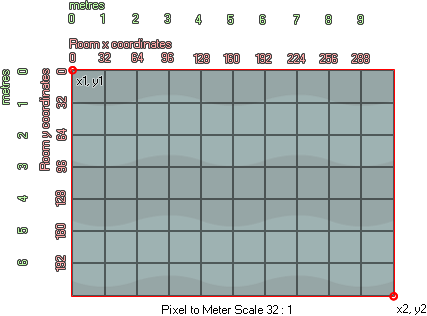
physics_world_create(pixeltometrescale);
| Argument | Description |
|---|---|
| pixeltometrescale | defines the ratio of pixels on screen to metres in the real world. A ratio of 32:1 will be specified as 1/32 (or 0.03125). |
Returns: N/A
Even if you have defined the physics for your objects, without a
world to place them in they will default to the traditional
GameMaker: Studio collision system, so you need this
function to create the physics system for the specified room either
in an object event, or the creation code of the room itself (it can
also be defined without using code in the room editor). This
function will associate a physics "world" with the room and all
instances created in the room will behave using the physics that
has been defined for them and the world itself.

You'll notice that we have an argument that defines a ratio
between pixel size and metres. This is because the physics
functions work using real-world measurements and thus we must
translate pixel coordinates and pixel sizes into these real-world
measurements using a "pixel to metre scale". You'll want to adjust
the pixeltometrescale setting until the average pixel size
of the objects you are using translates roughly into simulated
physics objects of an appropriate size, and above you can see that
we have set it to 32 pixels being the equivalent of 1 metre. It
should be noted that the physics system will work with larger and
smaller ratios, but that the best performance is when the real
world measurements of your objects are no less than 0.1 metres and
no more than 50 metres.
physics_world_create(1/32)
The above code will create a physics world in the current room with a scale ratio of 32 pixels being the equivalent of 1 metre.